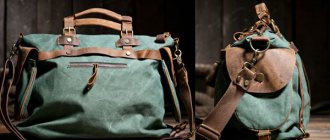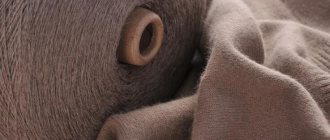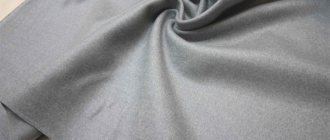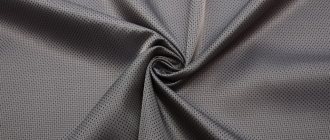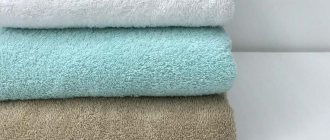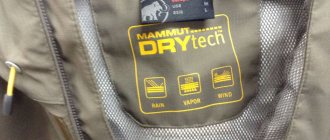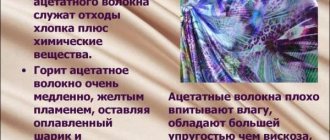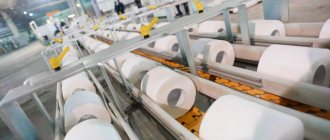Fabric type
Canvas is a fabric made from natural yarn created by plain weaving. It is rough and dense to the touch. Fabric without impregnation has a gray or beige tint (with impregnation - greenish). The canvas itself is durable and unpretentious, does not stain and does not deteriorate after washing, but in modern production synthetic fabrics are added to it for various purposes. This spoils the quality of the material.
The secret of the strength of natural (harsh) canvas is that when weaving, the threads are placed perpendicularly and very close to each other.
Wide VO/SKPV tarpaulin. Density 350 g. Width 160 cm
PRICE: 230.00 rub.
per linear meter. Add to cart Application in industry.
Due to its many beneficial properties, canvas is used in industries such as agriculture, construction, metallurgy and defense. As in ancient times, this fabric is also used for sails, since it does not wear out from mechanical stress and repels water, thanks to a special impregnation (a combination of impregnations).
Cloth.
The peak of canvas clothing came in the 20th century, in the 60s. Now I make jackets and raincoats, trousers and bags, shoes and overalls, as well as protective clothing from canvas. A travel bag made of canvas fabric would be a good choice, since its high strength will allow you to carry heavy items without harm.
An excellent solution would be to buy canvas shoes. High breathability prevents your feet from feeling suffocated, and experimental designs allow you to combine these shoes with different styles of clothing.
Home decoration – canvas curtains.
This fabric is truly unique, because it can be used to sew not only clothes, but also curtains. High density will protect the room from large amounts of dust, moisture, and ultraviolet radiation, so canvas curtains are perfect for libraries, storage facilities, warehouses and workshops.
For convenience, metal eyelets are sewn into the fabric, i.e. rings into which a steel guide is inserted. This protects the fabric from abrasions. The fabric may be subject to additional processing, depending on the accessory.
The density of the fabric also allows you to make a partition out of it, or to maintain the temperature in the room. At the same time, the humidity in the room will not increase, because the fabric has “breathable” properties. However, when buying or sewing curtains, it is worth considering that after the first wash the fabric will tighten, that is, it will settle.
Use in art.
Another advantage is that paints, especially oil paints, adhere well to thick canvas. For the first time, a picture was painted on canvas at the beginning of the 15th century, after first saturating the fabric with a primer so that the drawing lay more evenly.
Tarpaulin is not an expensive material, and it comes in many sizes, so any artist can choose something suitable for themselves and paint a picture.
Use in sports.
Due to its breathability, canvas clothing is also suitable for sports. For example, for judo, karate or other types of wrestling where control of the entire body is required. The use of tarpaulin is also recorded for covering canoes, since the fabric does not absorb moisture. Due to its strength, the fabric is suitable for creating trampolines.
TABLE OF CARGO PARAMETERS for calculating the cost of transportation | ||||||||
| Description of goods | vendor code | Density (g/sq.m.) | Roll length (m) | Roll width (m) | Roll height (m) | Roll volume (m³) | Roll weight (kg) | Approximate quantity per roll (m) |
| Harsh tarpaulin | 11135 D | 240 | 0,9 | 0,40 | 0,20 | 0,07 | 24,00 | 80 |
| Harsh tarpaulin | 11135 s | 280 | 0,9 | 0,42 | 0,22 | 0,08 | 27,00 | 80 |
| Harsh tarpaulin | 255 s | 330 | 0,9 | 0,42 | 0,22 | 0,08 | 31,00 | 80 |
| Tarpaulin OP | 11135 D | 340 | 0,9 | 0,42 | 0,22 | 0,08 | 24,00 | 80 |
| OP tarpaulin with | 11135 | 380 | 0,9 | 0,42 | 0,22 | 0,08 | 27,00 | 80 |
| Tarpaulin OP n | 11135 | 420 | 0,9 | 0,42 | 0,22 | 0,08 | 30,00 | 80 |
| OP tarpaulin with | 255 | 430 | 0,9 | 0,42 | 0,22 | 0,08 | 31,00 | 80 |
| Tarpaulin OP n | 255 | 450 | 0,9 | 0,42 | 0,22 | 0,08 | 32,00 | 80 |
| VO/SKPV tarpaulin with | 255 | 360 | 0,9 | 0,42 | 0,22 | 0,08 | 26,00 | 80 |
| Tarpaulin VO/SKPV n | 255 | 390 | 0,9 | 0,42 | 0,22 | 0,08 | 28,00 | 80 |
| VO/SKPV tarpaulin | 11293 | 400 | 0,9 | 0,44 | 0,24 | 0,09 | 29,00 | 80 |
| Tarpaulin OP | 11293 | 480 | 0,9 | 0,44 | 0,24 | 0,09 | 26,00 | 60 |
| Tarpaulin OP | 11292 | 530 | 0,9 | 0,44 | 0,24 | 0,09 | 28,00 | 60 |
| VO/SKPV tarpaulin | 11292 | 450 | 0,9 | 0,44 | 0,24 | 0,09 | 32,00 | 80 |
| Tarpaulin OP | 11252 | 660 | 0,9 | 0,42 | 0,22 | 0,08 | 30,00 | 50 |
| VO/SKPV tarpaulin | 11252 | 590 | 0,9 | 0,40 | 0,20 | 0,07 | 26,00 | 50 |
| Tarpaulin OP | 1P1135 | 400 | 0,9 | 0,45 | 0,24 | 0,10 | 39,00 | 100-125 |
| Tarpaulin OP | 11255 | 460 | 0,9 | 0,45 | 0,24 | 0,10 | 43,00 | 100-110 |
| Tarpaulin VO | 11255 | 460 | 0,9 | 0,45 | 0,24 | 0,10 | 44,00 | 110-125 |
| OP wide tarpaulin | OP/150 | 430 | 1,5 | 0,33 | 0,16 | 0,05 | 29,00 | 40-50 |
| OP wide tarpaulin | 11293 | 480 | 1,6 | 0,33 | 0,16 | 0,05 | 34,00 | 40-50 |
| Wide VO/SKPV tarpaulin | VO/150 | 350 | 1,5 | 0,33 | 0,16 | 0,05 | 24,00 | 40-50 |
What is canvas?
Origin story
The word "canvas" has Greek roots. In ancient times, the material was made mainly from hemp. In Rus' (our word “canvas” is from Greek), the name was due to the fact that sails were sewn from fabric - an important material for the state after the opening of new sea routes and the strengthening of the role of the fleet. In the 15th century, the importance intensified - at this time, flotillas plied the seas and were more important than ground forces.
The manufacturing method has not changed over the centuries - it is laying thick threads on top of each other, thanks to this technology it is difficult to tear the material.
Fabric composition and properties
Hemp, flax, and jute are used to create canvas. There is also semi-linen canvas - a combination of linen and cotton. When synthetic fabrics and materials are added, the characteristics of the material change (often for the worse).
Density ranges from 300 to 600 g/m2, and color - from gray and beige to protective and green (after impregnation).
Properties of the fabric: durable, dense, protected from water and wind, but breathable (this is important for clothing), not subject to temperature changes, does not burn well, and its price is low. Even with a knife it is difficult to pierce it through.
However, canvas (without impregnation) is heavy, takes a long time to dry, and can rot.
Application of different types of canvas
Canvas is used in various industries: defense, agriculture, metallurgy, construction and other various fields. The main function of this material is protective. Therefore, durable protective clothing is made from it, protecting against fire, humidity, acid and aggressive external influences. Costumes for firefighters, rescuers and stuntmen are made from fire-resistant canvas canvas. In factories, canvas uniforms are also more than appropriate: they perfectly protect against damage from tools, sharp parts and machines.
Of course, sails are still made from canvas, which differ, it should be noted, in their resistance to heavy loads and the effects of salt water, sunlight and precipitation.
During the First World War, the production of canvas increased hundreds of times, because weapons, equipment, and soldiers needed to provide temporary shelter that could be assembled and moved to the desired area without much effort. Canvas awnings, tents and awnings still provide excellent protection from wind, snow and rain to thousands of military personnel, archaeologists and tourists.
It should be noted that in our time, canvas is used not only for sewing work uniforms, but also for creating everyday clothes, shoes and accessories. Today, fashionable jackets, overalls, trousers, sports shoes and various ammunition are made from canvas.
Canvas is, among other things, a reliable protector from dust and light. Therefore, rough curtains are often sewn from canvas canvas for workshops, warehouses and car washes to prevent moisture, dust and precipitation from entering the premises. With the help of canvas, separate workplaces for office employees can be organized. In this case, the canvas acts as simple partitions.
They found use for canvas and in decoration. Thin canvas has a fairly aesthetic appearance, so people like to use it to decorate apartments, cafes and even restaurants in a fashionable ethnic style and eco style. Curtains are made from canvas, elegant canopies are sewn and upholstery is made for upholstered furniture.
Artists also fell in love with canvas. Just imagine, the first painting painted on canvas dates back to the 15th century! Canvas canvases are still relevant in painting and for non-traditional creative expression today. Tarpaulin is valued for its availability and variety of sizes. Artists can use it to create very unusual business cards, as well as wall-sized works.
Canvas is also indispensable in sports. Clothes for some areas are made from it, for example, wrestling or judo. Canvas canvas is also used to cover canoes. Trampolines intended for sports and entertainment are also made using canvas canvas.
Types of fabric
Canvas options
Canvas is made from the following natural raw materials:
- linen;
- hemp;
- jute (mined in Asia, America and Africa);
- linen and cotton.
Canvas comes with impregnation (tarpaulin) and without. Tarpaulin has become widespread - there are tents made from it, technical clothing and shoes. Covers that do not get wet are also made of canvas.
Density levels:
- 11252 skpv - light-resistant, waterproof, bioresistant impregnation;
- 11293 skpv - has the same characteristics, lower density;
- 11293 op - with fire-resistant treatment;
- 11135 op - the same characteristics, lower density.
Tarpaulin
Strength and wear resistance: an overview of the properties of tarpaulin fabric
more details
How much does the fabric sell for?
On average: 70-250 rubles per linear meter. Look at the article number to understand what the canvas is made of and the presence of impregnation. The price may depend on various factors: for example, canvas made of cotton and jute can cost 170-220 rubles per meter. White furniture is the most expensive (more than 600 rubles per meter). Fabrics made from jute and synthetic fibers are less durable than those made from other raw materials.
Canvas today has not lost its relevance and amazes with its properties. This durable material can last a long time as clothing, shoes or a tent. The potential is enormous, but often during production they replace flax with fragile jute and add synthetic fabrics. At various times, canvas has inspired trendsetters (Levi Strauss made jeans in 1850).
Some fashion designers are trying to come up with new ways to make this material fashionable, such as creating jackets, vests and shoes. Some handmade craftsmen and seamstresses use this fabric for their orders and achieve high quality items.
Areas of use
Based on the name, canvas is a fabric that was used to make sails. However, starting with the advent of ships with steam engines, this material began to increasingly find other uses, and even played a significant role in the history of fashion. Inexpensive and durable clothes (suits, trousers, jackets, summer raincoats - “dusters”) were made from thin linen and half-linen canvas, as well as light summer shoes, which were widely used until the middle of the last century. Of great interest is the history of durable, cheap trousers made of waste canvas, which in 1850 the emigrant tailor Levi Strauss began selling to prospectors in the gold mines of California, thereby marking the beginning of the denim style.
Just like centuries ago, canvas cases, bags, jackets, and various accessories are in demand. Curtains and other canvas home textiles are strong and durable, and are very suitable for creating a Mediterranean or minimalist style interior. The use of tarpaulin deserves a special mention. It is traditionally used for protective clothing and special equipment for workers in hot shops, firefighters and other dangerous professions, and is widely used in military and special forces. Until now, tents, awnings, backpacks and other tourist and hunting equipment made from this reliable material have been produced and are in great demand . Although such products are quite heavy and afraid of getting wet, they are valued for their practicality, reliability and low price. However, when purchasing a modern product made of canvas or tarpaulin, it is necessary to clarify its composition, since the addition of synthetic fibers to this fabric can have a very negative impact on its properties.
